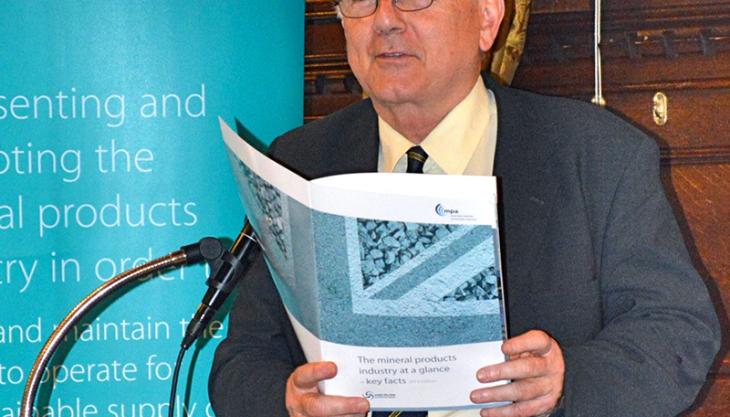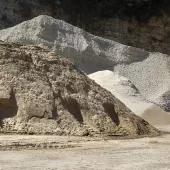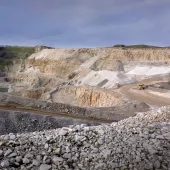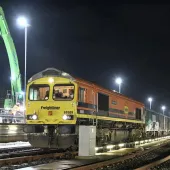Latest industry ‘Facts at a Glance’

Parliamentary launch for MPA’s 2nd Edition of ‘Facts at a Glance’ on mineral products industry
FOLLOWING the MPA’s General Assembly, a Parliamentary Reception hosted by Roger Williams MP, co-chair of the All-Party Parliamentary Minerals Group, saw the launch of the new 2nd edition of the MPA’s ‘Facts at a Glance’ publication, which offers a comprehensive insight into the essential contribution of the mineral products industry to the economy and sustainability, as well as the challenges it faces.
Key facts from the document are:
- 250 million tonnes is the mineral products industry’s annual production.
- £9 billion is the annual industry turnover.
- £400 billion is the turnover of industries it supplies.
- £120 billion is the value of construction, the industry’s main customer.
- 70,000 is the number of people employed in the mineral products industry.
- 2.5 million is the number of jobs supported through its supply chain.
- Materials in the MPA scope accounted for 65% of total UK production of minerals in 2012 (including crude oil/natural gas/coal).
- In 2013, 103 million tonnes of aggregates were produced in England, 27 million tonnes in Scotland, 18 millon tonnes in Northern Ireland and 13 million tonnes in Wales.
- In 2013, crushed rock accounted for 45% of all GB aggregate sales, recycling 28% and sand and gravel 27%.
- The UK has moved from being a net exporter to being a net importer of concrete products since 2009.
- The annual cost of the aggregates levy was equivalent to 31% of industry gross value added (GVA) in 2012.
- The total cost of climate change and energy measures is estimated to rise from an equivalent of 15% of the GVA of the cement industry in 2013 to 65% by 2020.
- Use of aggregates and cement per capita in the UK is about 35% and 60%, respectively, below the European average.
Speaking at the event, Alun Cairns MP of No.10 Policy Unit and MP for Vale of Glamorgan, said: ‘The mineral products industry needs to be recognized as critical to our future economic and social prosperity. This ‘Facts at a Glance’ booklet demonstrates the industry's contribution.
‘The growth strategy is clear: more high-tech, high-growth industries are needed, like aerospace and digital communications. We also need enabling industries like construction and its supply chain.
‘The booklet makes the link between the materials produced and the built environment, as well as their value as an enabler for downstream economic activity. I congratulate you on the work you are doing to help rebuild the country.’
Mary Creagh MP, Shadow Secretary of State for Transport and MP for Wakefield, said: ‘I am well aware of the importance of your industry as the main supplier for future transport and infrastructure investment and in my new job that’s what I want this country to be all about.
‘We want more strategic investment to get our infrastructure up to scratch; more house building, we are currently at the lowest level of peacetime house building since the 1920s; and more construction jobs.
‘You have been doing some very good work, particularly on HGVs and cycle safety, learning from the work you’ve done on cyclist and pedestrian safety devices. If cycling was a pill, doctors would be prescribing it: it’s fun, it’s safe, it’s low cost and everybody should have access to that enjoyment. But we do have to balance that with those critical HGVs bringing supplies of food and construction materials into our big cities, and it is a particular issue in London with the disproportionate number of HGVs involved in cyclist fatalities.
‘I’m convinced of the economic and environmental benefits of boosting infrastructure, roads, rail and air. Let’s make sure your drivers, the cyclists, the pedestrians, the car drivers and the other road users get home safe every day.
‘Working together, let’s build a better transport system, build the infrastructure this country needs and put this country back on its feet.’
Sir Peter Bottomley MP (pictured), MP for Worthing West, said: ‘We can endorse this excellent update on the key facts and figures for our important indigenous industry. The UK gains by the minerals that underpin so many other industries, from construction to steel making, glass to agriculture. The industry is trying hard to be sustainable and responsible. This is successful and important.’
Nigel Jackson, chief executive of the MPA, said: ‘The hard-earned recovery must not be taken for granted. It needs continual nurturing to maintain momentum, to minimize uncertainty and maximize confidence to encourage investment. We are also aware of the political decisions that lie ahead in the UK and the risks and uncertainties in Europe, the US and beyond.
‘If 2014 continues to unfold positively and we progressively address the massive cumulative under-build in housing, the need to replace our energy infrastructure, repair our roads and extend our rail network, the prospects for both the short and medium term can remain very positive.
‘Why is our ‘Facts at a Glance’ publication worthy of attention? Because we have to keep grinding out the facts and evidence, not only to inform policy thinking on mineral resources and their use as essential products, but to try to influence policy. It’s an evidence-based world and no evidence probably means little influence – and there is no more powerful evidence than good data, well presented.
‘Our second edition has filled many of the gaps of the first and is richer, more inclusive geographically and reaches across the full product spectrum. For MPA members this document is part of our ‘Make the Link’ toolbox: ‘making the link’ between our quarries, plants and factories and our roads, hospitals, schools, housing and energy infrastructure, and the essential mineral products they rely on.’
The data in the MPA’s ‘Facts at a Glance’ publication are presented simply and succinctly, using easy-to-interpret graphs and charts. Using this visual approach, the document highlights the industry’s economic importance, such as how it supports other sectors and its comparative productivity; provides product information, such as sales volumes and where production is concentrated; analyses the issue of maintaining long-term aggregate supply, by looking at permitted reserves and replenishment rates; sets out the cumulative burden of taxation and regulation on the industry; and examines the industry’s contribution to sustainability using data on the share of recycled materials in total aggregate sales, carbon dioxide emission reductions and biodiversity delivery.
The new compendium also includes profiles on a broader scope of products, including: industrial lime, agricultural lime, mortar, dimension stone and industrial sand.
‘Facts at a Glance’ can be downloaded from the Publications section of the MPA website.







